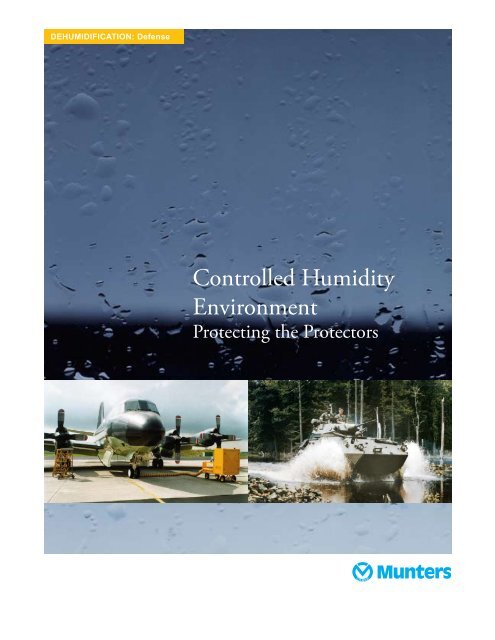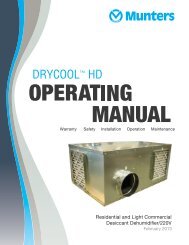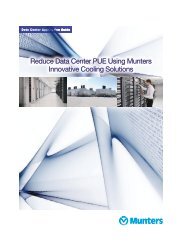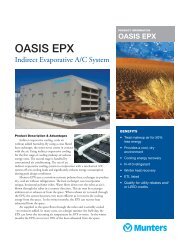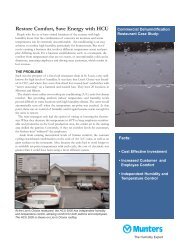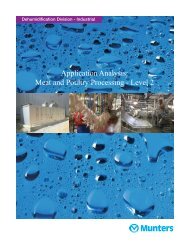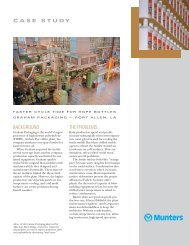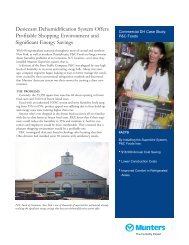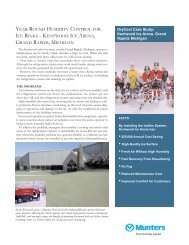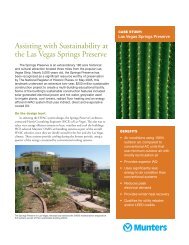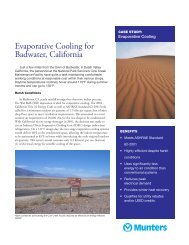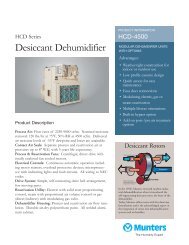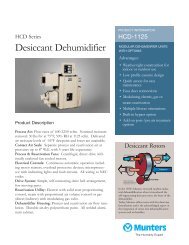Controlled Humidity Environment - Munters
Controlled Humidity Environment - Munters
Controlled Humidity Environment - Munters
Create successful ePaper yourself
Turn your PDF publications into a flip-book with our unique Google optimized e-Paper software.
DEHUMIDIFICATION: Defense<br />
<strong>Controlled</strong> <strong>Humidity</strong><br />
<strong>Environment</strong><br />
Protecting the Protectors
In peacetime, humidity is the biggest enemy<br />
of defense equipment<br />
The time that defense equipment is actually used is very limited; when<br />
compared with non-use time. This is logical for equipment in storage,<br />
but even “active status” equipment is not used most of the time and<br />
stands parked somewhere. Deployed equipment that is parked or on<br />
“Stand By” might have to be made available immediately, without the<br />
hassle of solving malfunctions first.<br />
During times that the equipment is not being used, it suffers from<br />
the high ambient relative humidity (RH). The average RH in many<br />
places around the world is approximately 80%. Corrosion, electronic<br />
malfunctions, fungus, chemical decomposition, etc. are all a result of<br />
humidity that is present in ambient air by nature.<br />
<strong>Munters</strong>, the <strong>Humidity</strong> Expert<br />
<strong>Munters</strong> has solutions which take the excess humidity out of the<br />
air. The result: less corrosion, fewer malfunctions, better availability,<br />
longer inspection and maintenance intervals, more time for training<br />
and over the total lifetime of the equipment significantly lower “Life<br />
Cycle Costs”.<br />
With more than 20,000 dehumidifiers in use on defense<br />
applications worldwide, <strong>Munters</strong> has a proven track record in effective<br />
partnering to solve humidity related problems.<br />
Dehumidification is not a strictly military affair..... Many well known<br />
civilian companies use our technologies to protect their production<br />
processes, stocks and logistics. We count companies like Nestlé,<br />
Intel, Daimler-Chrysler, Siemens, Pfizer and Walmart among our<br />
customers.<br />
The sorption rotor, invented by <strong>Munters</strong><br />
Carl <strong>Munters</strong> is the inventor of the sorption rotor or Honeycombe®<br />
desiccant wheel. The working principle is very simple:<br />
Process air passes through the drying wheel and leaves the<br />
dehumidifier as dry air.<br />
Heated reactivation air collects the moisture absorbed by the drying<br />
wheel and leaves the dehumidifier as wet air.<br />
Because a sorption rotor is not temperature dependent, the moisture<br />
removal capacity is superior under various climatic conditions that<br />
should occur the whole year round, or even through one 24 hour<br />
cycle.<br />
Many defense forces around the world have put their trust in this<br />
effective technology...... Simple Magic.
Saving money by lowering the relative<br />
humidity<br />
In a military environment many costs can be avoided by lowering the relative<br />
humidity (RH). A lower RH than what nature offers us will dramatically<br />
influence the amount of moisture damage that normally occurs.<br />
Corrosion<br />
Research done by Vernon back in the 1920’s has shown that there is a direct<br />
and exponential relation between corrosion on steel and the relative humidity<br />
in the space. Further investigations have shown that this also applies to other<br />
metals and combinations of metals. A recent USAF study shows that 20% of<br />
all electronic malfunctions are caused by corrosion.<br />
Electronic malfunctions<br />
Along with corrosion, the RH also has a clear influence on resistance values<br />
of insulation materials. This leads to frequent malfunctions during the startup<br />
of electronics that disappear later, when the component is tested in a<br />
workshop. These “No Fault Found” (NFF) or “Could Not Duplicate” (CND)<br />
phenomena reduce the “Mean Time Between Failure” (MTBF) unnecessarily<br />
and are a burden to the logistic system.<br />
In extreme cases a high RH can lead to arcing. In those cases electronic<br />
components are often damaged beyond repair, potentially becoming a fire<br />
hazard.<br />
Fungus<br />
The development of fungus depends on humidity and temperature. At<br />
ambient RH conditions fungus development is considerable. By lowering<br />
the RH, current fungus growth can be destroyed and future fungus growth<br />
is prevented completely.<br />
Chemical decomposition<br />
<strong>Humidity</strong> in the air can also be a component in a chemical reaction, often<br />
with undesirable consequences. For example, due to humidity, ammunition<br />
can turn unstable and therefore become very dangerous. By lowering the<br />
RH in the storage environment the safe shelf life of the ammunition can be<br />
prolonged.<br />
Experiences<br />
Findings by the “General Accounting Office” (GAO) show that up to 25%<br />
can be saved on maintenance costs when the “Dry Air Method” is used.<br />
These findings are corroborated by experiences of the Swedish Defence<br />
Materiel Administration. The Australian Defence Science and Technology<br />
Organisation (DSTO) also supports the use of the “Dry Air Method”.<br />
With assistance from <strong>Munters</strong>, many nations have similar experiences on a<br />
wide variety of equipment: aircraft (fixed and rotary wing), armored vehicles,<br />
truck mounted shelters, radar systems, ships, ammunition, logistic supplies,<br />
etc..
Application examples<br />
Vehicles and equipment stored in <strong>Controlled</strong> <strong>Humidity</strong> <strong>Environment</strong> (CHE). The storage building<br />
does not require heating and the equipment is kept at high quality while inspection intervals are<br />
prolonged. Many allied forces use this storage technique as it is proven to be most effective.<br />
Ammunition is typically stored in magazines which are partly earth covered. Usually, ammunition<br />
magazines have a high humidity inside, resulting in corrosion damage and the quick decomposition<br />
of chemical compounds. <strong>Munters</strong> sorption dehumidifiers create an environment where corrosion<br />
is slowed down and the safe life of the ammunition is extended.<br />
By using portable <strong>Munters</strong> equipment, ammunition stocks as well as heavy equipment can be<br />
protected during Out of Area Operations. Our equipment has seen operation in most peace<br />
keeping missions and Out of Area Operations in recent years. The picture on the left shows<br />
ammunition containers in Liberia.<br />
Several <strong>Munters</strong> dehumidifiers are suited for demanding applications where the dehumidifier is<br />
built into a system. These dehumidifiers are shock and vibration proof and meet the high standards<br />
that are normally set for these applications. <strong>Munters</strong> can also advise on how to use this equipment<br />
in combination with RFI/EMP or NBC protective requirements.<br />
Especially in a corrosive naval environment, dehumidification can be very rewarding. <strong>Munters</strong><br />
is a world leader in the protection of platform systems, such as gearboxes and shafts, as well as<br />
weapon and sensor systems. Latest “state of the art” technology, such as the Thales APAR radar<br />
is protected with <strong>Munters</strong> equipment.<br />
Aircraft and helicopters benefit very much from dehumidification. In many cases, electronic<br />
malfunctions are reduced by 50% or more. The structure and engine also benefit from the dry<br />
air because the low humidity stops corrosion. With transport aircraft, condensation is a common<br />
phenomenon during high altitude flight. <strong>Munters</strong> dehumidifiers dry the insulation blankets<br />
whenever the aircraft are connected.<br />
<strong>Munters</strong> Corporation - DehuMiDifiCation Division<br />
79 Monroe street, po Box 640, amesbury, Ma 01913<br />
teL: (978) 241-1100 or (800) 843-5360, faX: (978) 241-1214<br />
e-mail: dhinfo@munters.com<br />
WWW: http://www.munters.us<br />
M162120 Rev.0 12/08<br />
©2008 <strong>Munters</strong> Corporation


